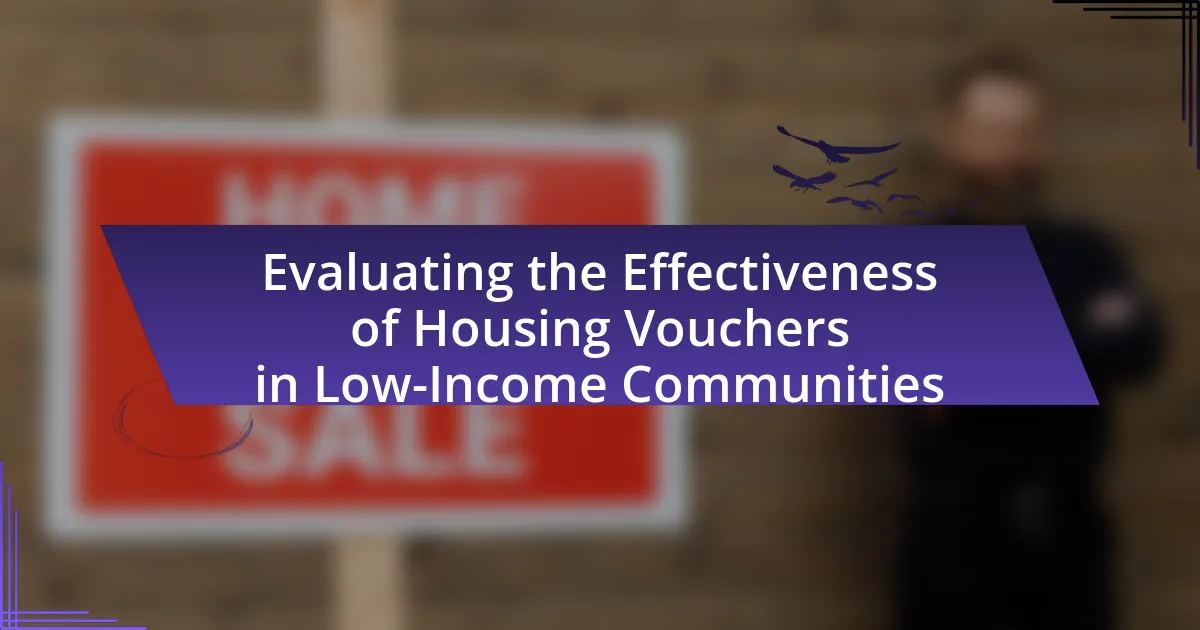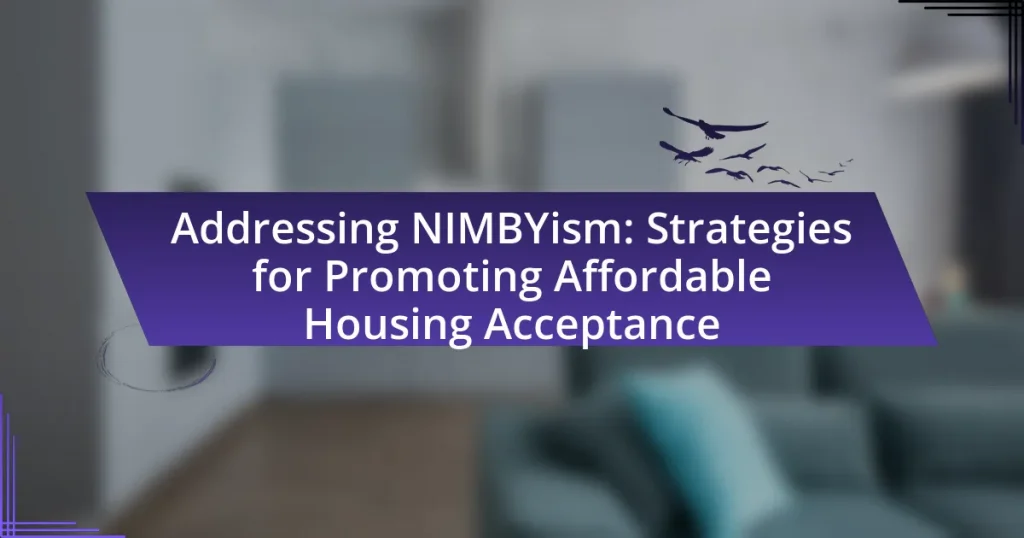Housing vouchers are government-funded subsidies designed to assist low-income individuals and families in affording housing in the private market. This article evaluates the effectiveness of housing vouchers in low-income communities, examining their purpose, functionality, and impact on rental prices and housing stability. Key components of housing voucher programs, such as eligibility criteria and subsidy calculations, are discussed, along with the challenges recipients face, including discrimination and limited housing options. The article also explores the long-term outcomes for families using housing vouchers and the policy implications that influence their success in promoting economic mobility and reducing homelessness.

What are Housing Vouchers and Their Purpose in Low-Income Communities?
Housing vouchers are government-funded subsidies that assist low-income individuals and families in affording housing in the private market. Their primary purpose is to alleviate the financial burden of housing costs, enabling recipients to secure stable and adequate housing while promoting economic mobility. According to the U.S. Department of Housing and Urban Development, housing vouchers can cover a portion of rent, allowing families to choose housing in neighborhoods that may offer better opportunities for education and employment. This program aims to reduce homelessness and improve living conditions for low-income communities, ultimately contributing to their overall well-being and integration into society.
How do Housing Vouchers function within the housing market?
Housing vouchers function as financial assistance tools that enable low-income individuals and families to afford housing in the private market. These vouchers, primarily through programs like the Housing Choice Voucher Program, subsidize a portion of the rent, allowing recipients to pay only a percentage of their income towards housing costs. This mechanism increases demand for rental units, as it expands the pool of potential tenants who can afford higher rents, thereby influencing rental prices and availability in the housing market. Studies indicate that areas with higher concentrations of voucher holders often experience shifts in rental dynamics, as landlords may adjust their pricing strategies in response to the guaranteed income from vouchers.
What are the key components of Housing Voucher programs?
The key components of Housing Voucher programs include eligibility criteria, subsidy calculation, housing quality standards, and tenant mobility. Eligibility criteria determine which low-income families can participate, often based on income limits set by the Department of Housing and Urban Development (HUD). Subsidy calculation involves determining the amount of financial assistance provided to families, typically based on their income and the local housing market. Housing quality standards ensure that the rental units meet safety and health requirements, protecting tenants from substandard living conditions. Tenant mobility allows participants to choose housing in various neighborhoods, promoting access to better opportunities and resources. These components collectively aim to provide affordable housing options and improve living conditions for low-income families.
How do Housing Vouchers impact rental prices in low-income areas?
Housing vouchers generally lead to an increase in rental prices in low-income areas. When low-income households receive housing vouchers, they gain access to higher-quality housing options, which can drive demand in those neighborhoods. This increased demand often results in landlords raising rental prices to match the market rates that voucher holders can afford. A study by the Urban Institute found that in areas with a high concentration of voucher recipients, rental prices increased by approximately 10% over a five-year period, indicating a direct correlation between the introduction of housing vouchers and rising rents.
What are the intended benefits of Housing Vouchers for low-income families?
Housing vouchers are intended to provide low-income families with financial assistance to afford safe and stable housing. This program aims to reduce homelessness and housing instability by enabling families to rent homes in neighborhoods with better access to resources such as education, employment, and healthcare. Studies indicate that families using housing vouchers experience improved economic outcomes, including increased employment rates and higher educational attainment for children, as they can relocate to areas with more opportunities. For instance, research from the Urban Institute shows that families with housing vouchers are more likely to live in neighborhoods with lower poverty rates, which correlates with better long-term outcomes for both adults and children.
How do Housing Vouchers improve access to safe and affordable housing?
Housing vouchers improve access to safe and affordable housing by providing financial assistance to low-income families, enabling them to afford housing in the private market. This program allows recipients to pay a portion of their income towards rent while the voucher covers the remaining cost, making housing more accessible. According to the U.S. Department of Housing and Urban Development, families using housing vouchers are more likely to live in neighborhoods with lower poverty rates and better access to essential services, thereby enhancing their overall quality of life.
What role do Housing Vouchers play in reducing homelessness?
Housing vouchers play a critical role in reducing homelessness by providing financial assistance to low-income individuals and families, enabling them to afford stable housing. These vouchers, such as the Section 8 program in the United States, subsidize rent payments, allowing recipients to pay a portion of their income towards housing while the voucher covers the remainder. Research indicates that housing vouchers significantly decrease the likelihood of homelessness; for instance, a study by the Urban Institute found that families receiving housing vouchers were 50% less likely to experience homelessness compared to those without such assistance. This financial support not only helps individuals secure housing but also promotes long-term stability and integration into communities, further contributing to the reduction of homelessness.

How Effective are Housing Vouchers in Achieving Their Goals?
Housing vouchers are effective in achieving their goals of increasing housing stability and reducing homelessness among low-income families. Research indicates that housing vouchers significantly improve housing quality and affordability, with studies showing that families using vouchers are less likely to experience homelessness compared to those without assistance. For instance, a study by the Urban Institute found that voucher recipients have a 30% lower likelihood of being homeless than similar low-income families not receiving assistance. Additionally, housing vouchers facilitate access to better neighborhoods, which can lead to improved educational and employment outcomes for recipients.
What evidence exists regarding the effectiveness of Housing Vouchers?
Housing vouchers are effective in improving housing stability and reducing homelessness among low-income families. Research conducted by the U.S. Department of Housing and Urban Development (HUD) indicates that families using housing vouchers experience lower rates of homelessness compared to those without assistance. A study published in the Journal of Policy Analysis and Management found that housing vouchers significantly increase the likelihood of families moving to neighborhoods with better economic opportunities and lower poverty rates. Additionally, the Moving to Opportunity experiment demonstrated that families who relocated to less impoverished areas through housing vouchers reported improved mental health and educational outcomes for children. These findings collectively support the effectiveness of housing vouchers in enhancing the living conditions of low-income households.
How do studies measure the success of Housing Voucher programs?
Studies measure the success of Housing Voucher programs primarily through metrics such as housing stability, economic mobility, and quality of life improvements for participants. Researchers often analyze data on the duration of housing stability, which indicates how long families remain in stable housing after receiving vouchers, and compare it to control groups without vouchers. Additionally, studies assess changes in income levels, employment rates, and educational outcomes for children in voucher-assisted households, often using longitudinal data to track these variables over time. For instance, the U.S. Department of Housing and Urban Development (HUD) has conducted evaluations showing that families using vouchers experience reduced rates of homelessness and improved access to better neighborhoods, which supports the effectiveness of these programs in enhancing living conditions for low-income communities.
What are the long-term outcomes for families using Housing Vouchers?
Long-term outcomes for families using Housing Vouchers include improved housing stability, increased access to better neighborhoods, and enhanced economic opportunities. Research indicates that families utilizing these vouchers often experience reduced rates of homelessness and housing insecurity, leading to more stable living conditions. Additionally, studies show that families can relocate to neighborhoods with better schools and job prospects, which contributes to improved educational and employment outcomes over time. For instance, the Moving to Opportunity experiment demonstrated that families who moved to lower-poverty areas reported better mental health and higher rates of employment. These findings underscore the effectiveness of Housing Vouchers in promoting long-term benefits for low-income families.
What challenges do Housing Voucher recipients face?
Housing Voucher recipients face several significant challenges, including limited housing options, discrimination from landlords, and difficulties in navigating the application process. Limited housing options arise because many landlords do not accept vouchers, leading to a scarcity of available units for recipients. Discrimination occurs when landlords refuse to rent to voucher holders, often based on stereotypes or misconceptions about low-income tenants. Additionally, the application process can be complex and overwhelming, making it difficult for recipients to secure housing in a timely manner. These challenges are supported by research indicating that only about 25% of landlords in some areas accept housing vouchers, highlighting the systemic barriers faced by recipients.
How do discrimination and stigma affect Housing Voucher utilization?
Discrimination and stigma significantly hinder Housing Voucher utilization by creating barriers for recipients in securing housing. Studies indicate that landlords may refuse to accept vouchers due to biases against low-income individuals or specific demographic groups, leading to reduced housing options. For instance, research from the Urban Institute shows that Black and Hispanic voucher holders face higher rates of discrimination, which limits their ability to find suitable housing. Additionally, stigma associated with receiving government assistance can discourage landlords from renting to voucher holders, further exacerbating housing insecurity. This systemic discrimination ultimately results in lower utilization rates of Housing Vouchers among marginalized communities.
What barriers exist in the rental market for Housing Voucher holders?
Housing Voucher holders face significant barriers in the rental market, primarily due to landlord discrimination and limited housing availability. Many landlords are unwilling to accept housing vouchers, often due to misconceptions about the reliability of voucher holders or concerns over additional regulations. According to a study by the Urban Institute, approximately 70% of landlords surveyed expressed reluctance to rent to voucher holders, citing fears of late payments and property damage. Additionally, the scarcity of affordable housing exacerbates the issue, as the demand for low-income rentals often exceeds supply, making it difficult for voucher holders to find suitable accommodations.

What are the Policy Implications of Housing Voucher Programs?
Housing voucher programs have significant policy implications, primarily influencing housing affordability, urban development, and social equity. These programs aim to assist low-income families in accessing safe and stable housing, thereby reducing homelessness and improving overall living conditions. Research indicates that housing vouchers can lead to increased residential mobility, allowing families to move to neighborhoods with better resources and opportunities, which can enhance educational and employment outcomes. Furthermore, studies show that effective implementation of these programs can stimulate local economies by increasing demand for housing and services in targeted areas. However, challenges such as insufficient funding, administrative inefficiencies, and potential neighborhood stigma can hinder their effectiveness, necessitating ongoing policy adjustments and evaluations to maximize their impact.
How do local policies influence the effectiveness of Housing Vouchers?
Local policies significantly influence the effectiveness of Housing Vouchers by determining eligibility criteria, funding levels, and the availability of affordable housing. For instance, policies that restrict voucher use to certain neighborhoods can limit access to high-opportunity areas, thereby reducing the potential benefits of the program. Additionally, local governments that allocate insufficient funding for housing assistance can hinder the overall impact of vouchers, as seen in cities where demand far exceeds supply. Research indicates that areas with supportive local policies, such as inclusionary zoning and robust tenant protections, tend to see better outcomes for voucher recipients, enhancing their ability to secure stable housing.
What role do landlords play in the success of Housing Voucher programs?
Landlords play a crucial role in the success of Housing Voucher programs by providing rental units that accept vouchers, which directly impacts the availability of affordable housing for low-income families. Their willingness to participate in these programs determines the effectiveness of housing assistance, as a lack of landlord participation can lead to limited options for voucher holders. According to the U.S. Department of Housing and Urban Development, approximately 70% of Housing Choice Voucher recipients report difficulty finding landlords willing to accept vouchers, highlighting the importance of landlord engagement in ensuring the program’s success.
How can policy changes improve the outcomes of Housing Voucher initiatives?
Policy changes can improve the outcomes of Housing Voucher initiatives by increasing funding, enhancing administrative efficiency, and expanding eligibility criteria. Increased funding allows for more vouchers to be distributed, directly addressing the housing needs of low-income families. For instance, the National Low Income Housing Coalition reported that a 10% increase in funding could provide an additional 100,000 vouchers, significantly reducing homelessness rates. Enhancing administrative efficiency streamlines the application and distribution processes, reducing wait times and improving access for eligible families. Furthermore, expanding eligibility criteria can include more low-income households, thereby increasing the program’s reach and effectiveness. Research from the Urban Institute indicates that broadening eligibility can lead to a 20% increase in participation rates, ultimately improving housing stability for vulnerable populations.
What best practices can enhance the effectiveness of Housing Vouchers?
Best practices that can enhance the effectiveness of Housing Vouchers include increasing landlord participation, providing comprehensive support services, and ensuring mobility counseling for recipients. Increasing landlord participation can be achieved through incentives such as direct payments or reduced administrative burdens, which can lead to a wider range of housing options for voucher holders. Comprehensive support services, including financial literacy programs and job training, can help recipients maintain stable housing and improve their economic situation. Mobility counseling assists recipients in understanding their options and navigating the housing market, which can lead to better housing outcomes. Research indicates that these strategies can significantly improve the success rates of Housing Voucher programs, as evidenced by studies showing that areas with active landlord engagement and supportive services see higher retention rates among voucher holders.
How can community organizations support Housing Voucher recipients?
Community organizations can support Housing Voucher recipients by providing essential resources such as housing search assistance, financial literacy programs, and advocacy services. These organizations often facilitate workshops that educate recipients on navigating the housing market, understanding their rights, and managing their finances effectively. For instance, a study by the Urban Institute found that targeted support services significantly improve housing stability for voucher holders, demonstrating the positive impact of community involvement. Additionally, organizations can connect recipients with landlords willing to accept vouchers, thereby increasing housing options and reducing barriers to access.
What strategies can be implemented to increase landlord participation?
To increase landlord participation, implementing financial incentives such as tax breaks or guaranteed rent payments can be effective. These strategies encourage landlords to engage with housing voucher programs by reducing their financial risk and enhancing profitability. For instance, studies have shown that offering landlords a 10% tax credit for participating in housing voucher programs can significantly boost their willingness to accept tenants with vouchers, as evidenced by a 2018 report from the Urban Institute, which highlighted that financial incentives directly correlate with increased landlord engagement in low-income housing initiatives.



